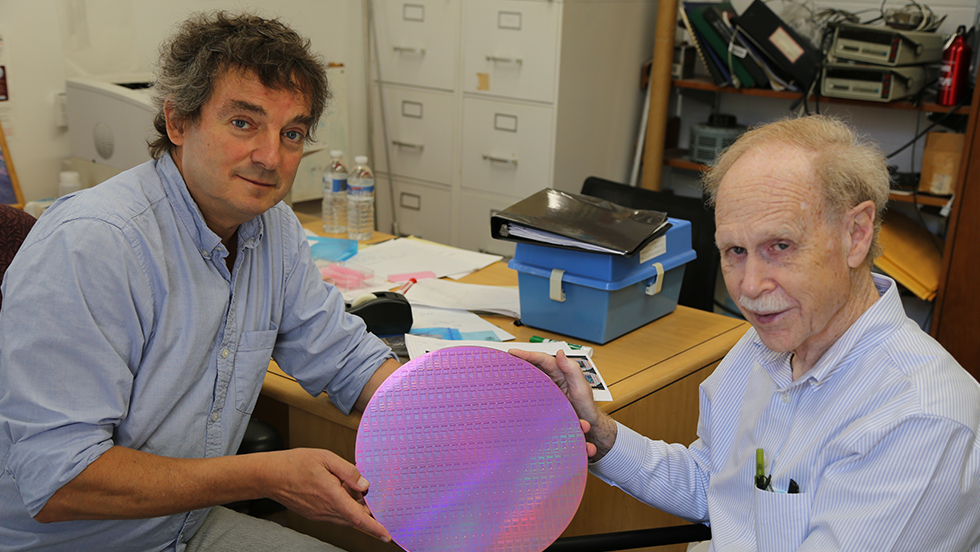The U.S. Department of Commerce’s National Institute of Standards and Technology (NIST) has signed a cooperative research and development agreement with Google to develop and produce chips that researchers can use to develop new nanotechnology and semiconductor devices. NIST, with university research partners, will design the circuitry for the chips, which will be open source, allowing academia and small businesses to use the chips without restriction or licensing fees. Brown’s Alex Zaslavsky and Bill Patterson are among the university researchers tasked with developing new chip designs.
The chips will be manufactured by SkyWater Technology at its Bloomington, Minnesota, semiconductor foundry. Google will pay the initial cost of setting up production and will subsidize the first production runs. NIST is partnering with researchers from Brown University, the University of Michigan, the University of Maryland, George Washington University and Carnegie Mellon University, who are all interested in characterizing silicon circuitry integrated with novel non-silicon sensors and devices.

“Modern silicon technology is extremely powerful, but it is based on producing large numbers of chips following an exacting fabrication process that typically does not permit deviations.” said Professor of Engineering and Physics Alex Zaslavsky. “This creates a major obstacle for universities or small technological start-ups in testing out new ideas. At Brown, in collaboration with physics department colleagues, we are working on silicon circuits intended for quantum sensing at cryogenic temperatures, with specific fabrication steps that deviate from the standard process flow.
“The NIST-Google collaboration will make it possible to have prototype circuits fabricated and tested, as well as to develop the hybrid integration of these circuits with our quantum magnetic field sensors.”
Large companies that design and manufacture semiconductors often have ready access to these types of chips. But the cost can run into the hundreds of thousands of dollars, presenting a major hurdle to innovation by university and startup researchers. By increasing production to achieve economies of scale and by implementing a legal framework that eliminates licensing fees, the collaboration is expected to bring the cost of these chips down dramatically.
“By creating a new and affordable domestic supply of chips for research and development, this collaboration aims to unleash the innovative potential of researchers and startups across the nation,” said Under Secretary of Commerce for Standards and Technology and NIST Director Laurie E. Locascio. This collaboration was planned before the recent passage of the CHIPS Act, but, Locascio said, “This is a great example of how government, industry and academic researchers can work together to enhance U.S. leadership in this critically important industry.”
Modern microelectronic devices are made of components that are stacked like layers in a cake, with the bottom layer being a semiconductor chip. The NIST/Google collaboration will make available a bottom-layer chip with specialized structures for measuring and testing the performance of the components placed on top of it, including new kinds of memory devices, nanosensors, bioelectronics and advanced devices needed for artificial intelligence and quantum computing.
NIST anticipates designing as many as 40 different chips optimized for different applications. Because the chip designs will be open source, researchers will be able to pursue new ideas without restriction and share data and device designs freely.
"Google has a long history of leadership in open-source,” said Will Grannis, CEO of Google Public Sector. “Moving to an open-source framework fosters reproducibility, which helps researchers from public and private institutions iterate on each other’s work. It also democratizes innovation in nanotechnology and semiconductor research.”
The SkyWater foundry will produce the chips in the form of 200-millimeter discs of patterned silicon, called wafers, which universities and other purchasers can dice into thousands of individual chips. At Brown, the team plans to fabricate arrays of very small but ultrasensitive magnetic field sensors directly on top of the silicon chips with analog and digital silicon control and read-out circuitry. The arrays will take high-resolution images of the local magnetic fields in ultrathin solid state systems, looking for fundamental quantum physics effects that have not been detected before.
NIST will host a virtual workshop Sept. 20-21, 2022, on the use of chips for measurement science and prototyping. The workshop will include a working group meeting on the NIST/Google collaborative research and development agreement that will be open to public participation. Information and registration instructions are available on the NIST website.